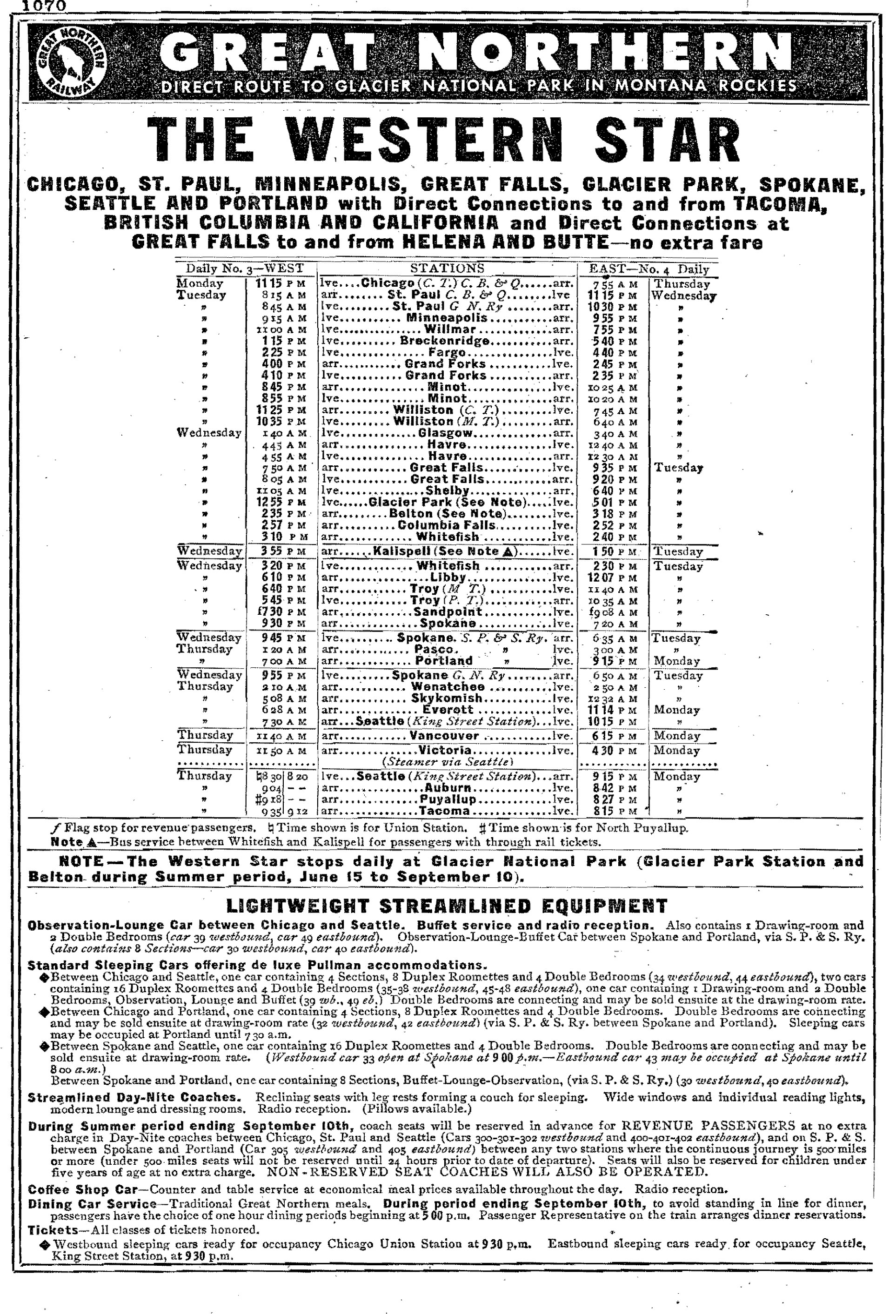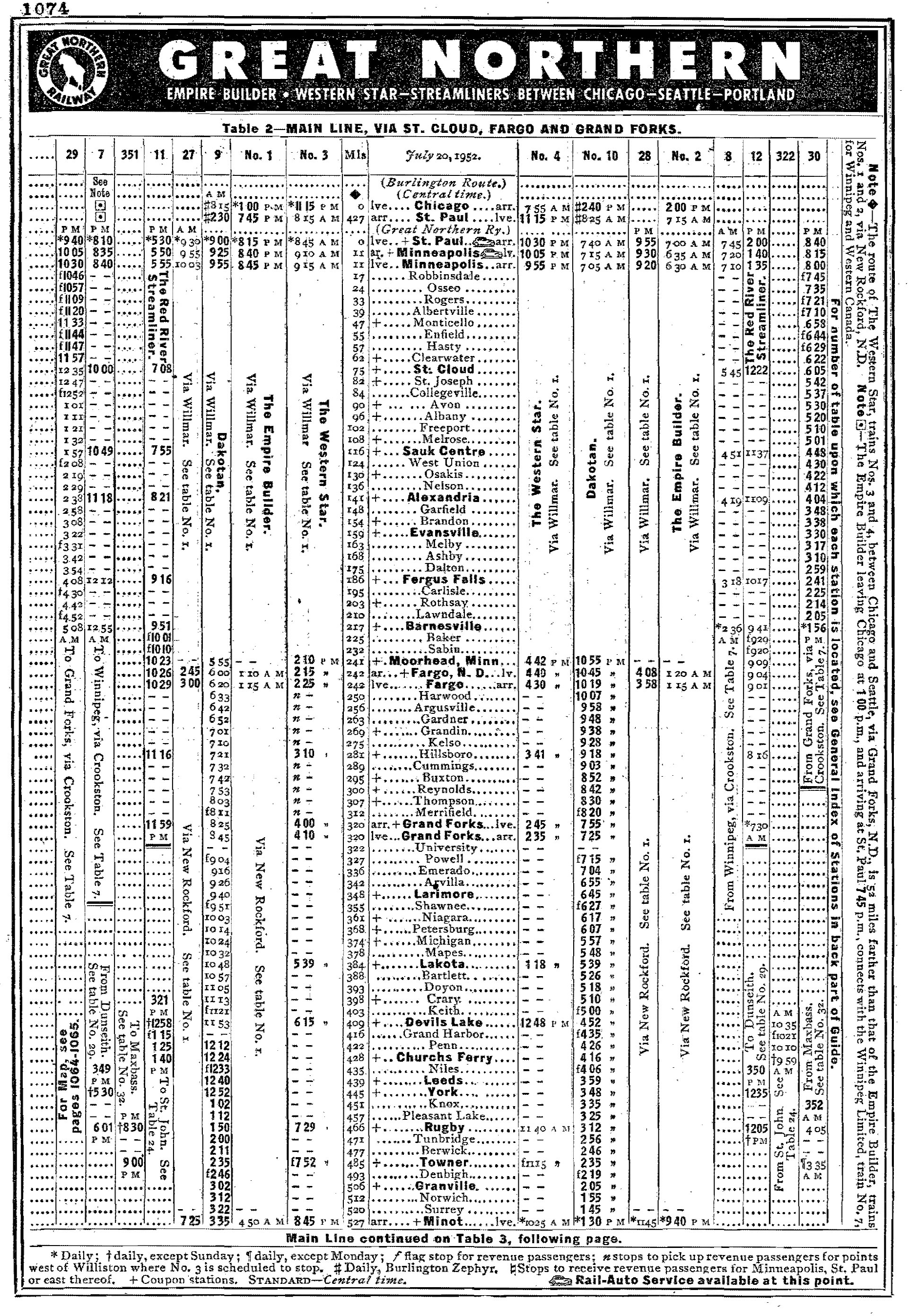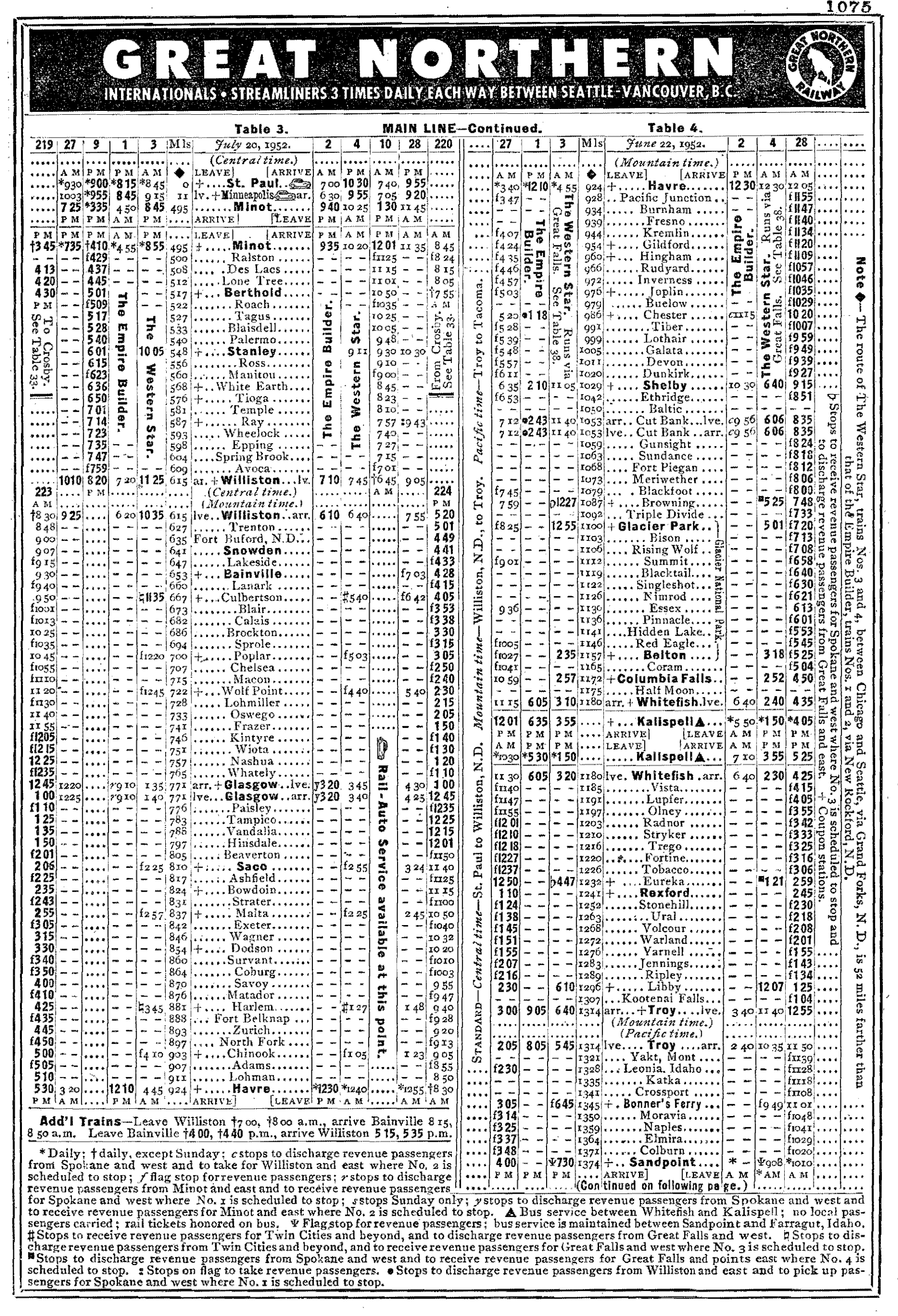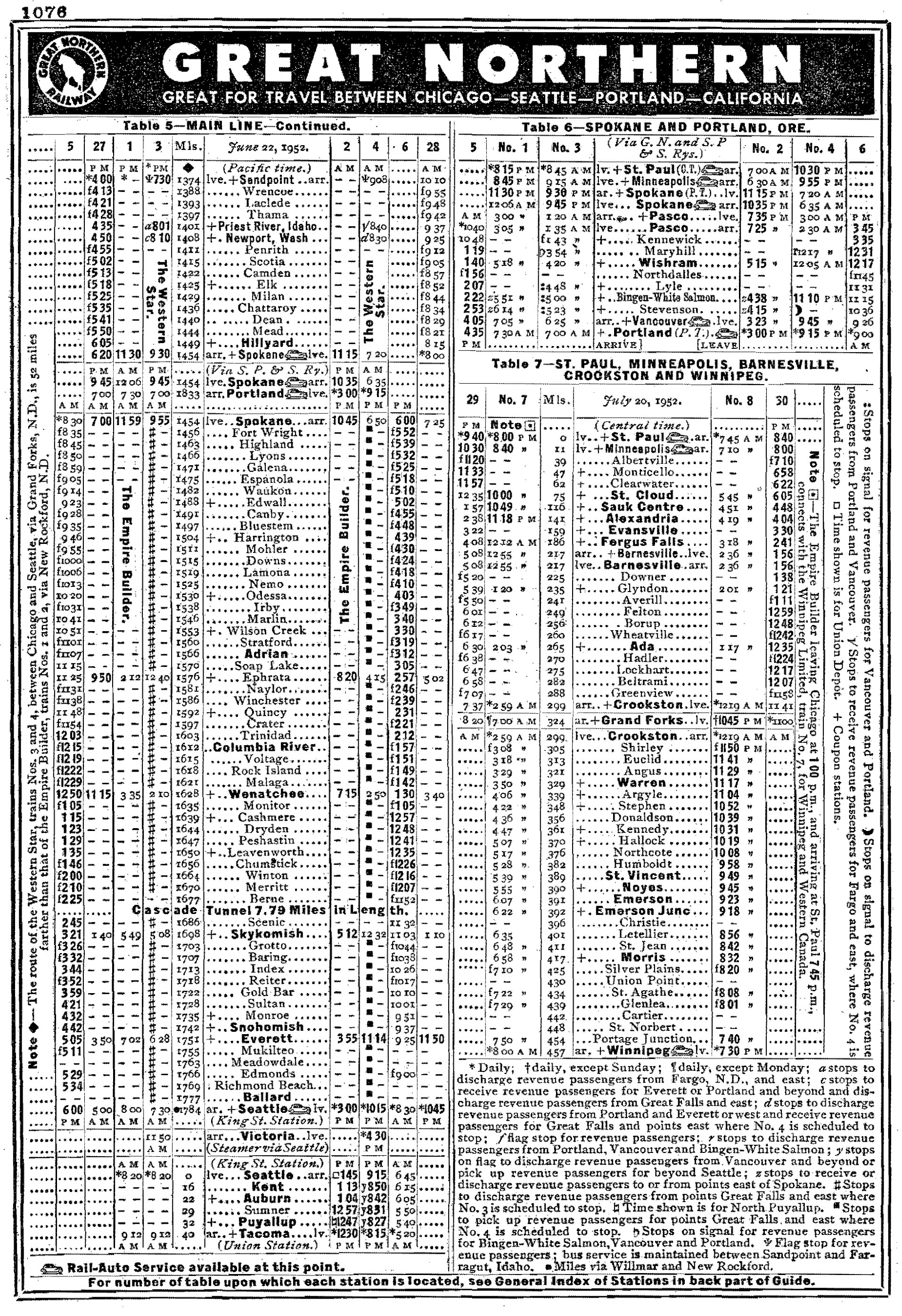"Western Star": GN's Secondary Seattle Train
Last revised: August 24, 2024
By: Adam Burns
When the streamliner craze hit the country in the mid-1930s it took the
Pacific Northwest railroads some time to adopt the new
service to their fleets, partly the result of World War II.
The first to do so was the Great Northern which updated its venerable Empire Builder in the late 1940s. The railroad again purchased new equipment for the train in the early 1950s which allowed it to unveil a brand new consist at that time, the secondary Western Star.
This train would compete loosely with the Northern Pacific's Mainstreeter and provided intermediate services that its flagship did not. The train proved quite successful for GN, in part due to the resounding success and publicity generate by the railroad's flagship service.
The Great Northern spent years advertising the Builder across the country, particularly in the streamliner era. You could find the train featured in magazines, newspaper, and even on television. The Star remained on the timetable through the end and was not discontinued until the startup of Amtrak in 1971.
Photos
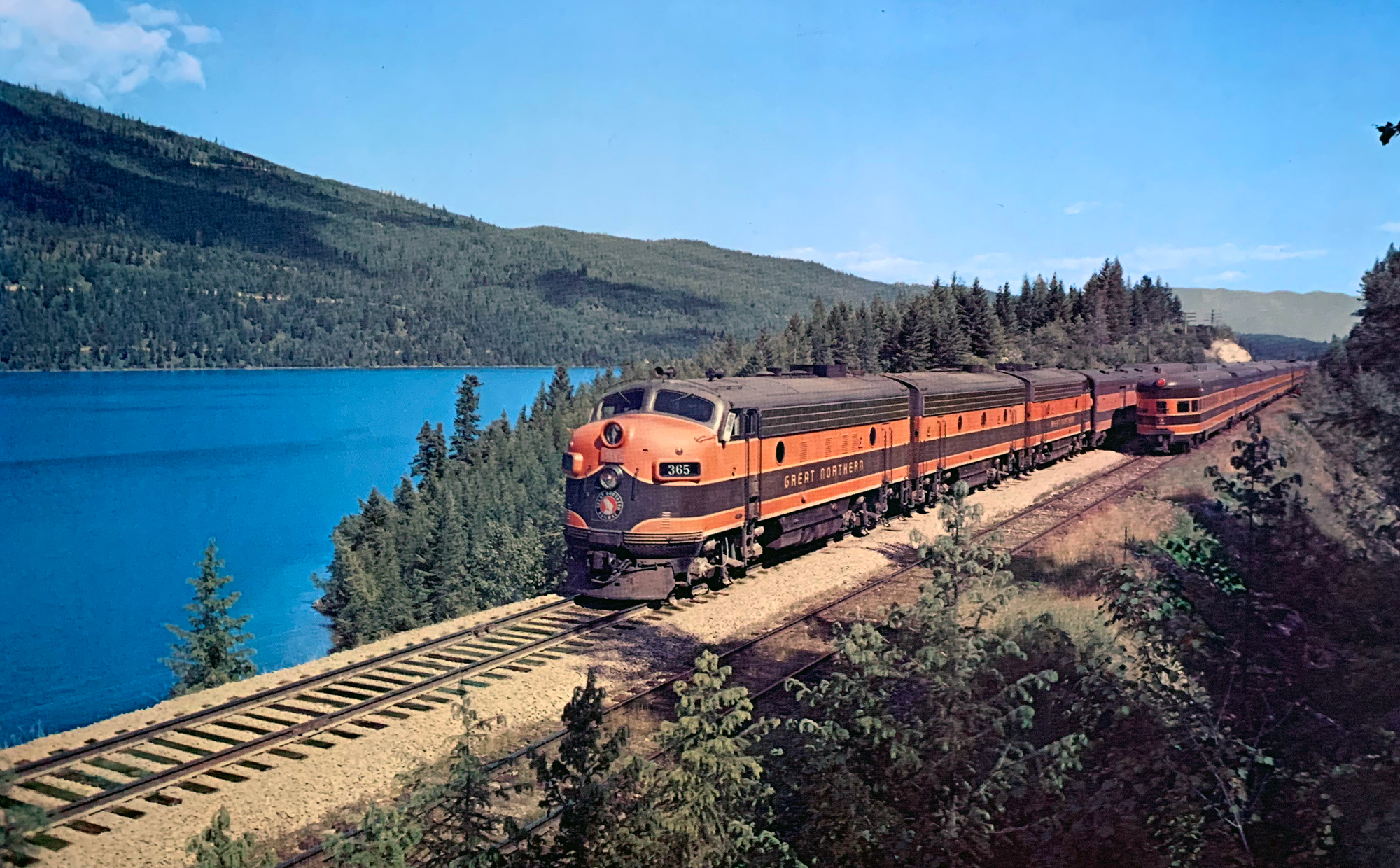 In this Great Northern publicity photo the eastbound and westbound "Western Star" meet at Whitefish Lake, Montana. Author's collection.
In this Great Northern publicity photo the eastbound and westbound "Western Star" meet at Whitefish Lake, Montana. Author's collection.History
Of the three transcontinental railroads serving Seattle and the Puget Sound (the others being the Milwaukee Road and Northern Pacific), the Great Northern offered the most prolific passenger services to and from the region.
Along with the Empire Builder there was the Oriental Limited (until 1951) and the Star. Additionally, the GN's Dakotan connected the Twin Cities to North Dakota and the railroad had numerous services into Canada particularly on the west coast.
Since 1900 the Builder was the GN's crack train between Seattle and Chicago although to reach the two cities required the help of ally road Chicago, Burlington & Quincy between the Twin Cities and Chicago.
The train was initially streamlined in February, 1947 with new equipment from Pullman-Standard, and then again updated in the late spring of 1951.
At A Glance
51 Hours, 45 Minutes 46 Hours, 40 Minutes |
|
47/27 (Westbound) 24/28 (Eastbound) | |
King Street Station (Seattle) Union Station (Chicago) |
After this latest round of equipment upgrades the Great Northern decided to inaugurate a secondary run between Seattle and Chicago, known as the Western Star, which debuted on June 3 of that year (the same date as the new Builder's inauguration).
The train's consist included a single coach, Day-Nite coaches, a lounge-coffee shop, diner, two sleepers, and a buffet-lounge-observation. Just like the Builder the train was clad in GN's beautiful passenger livery of orange and green.
The Star beat the Northern Pacific's Mainstreeter by a year although both trains served a very similar function; "mop up" duty carrying anything needed or required such as intermediate stops.
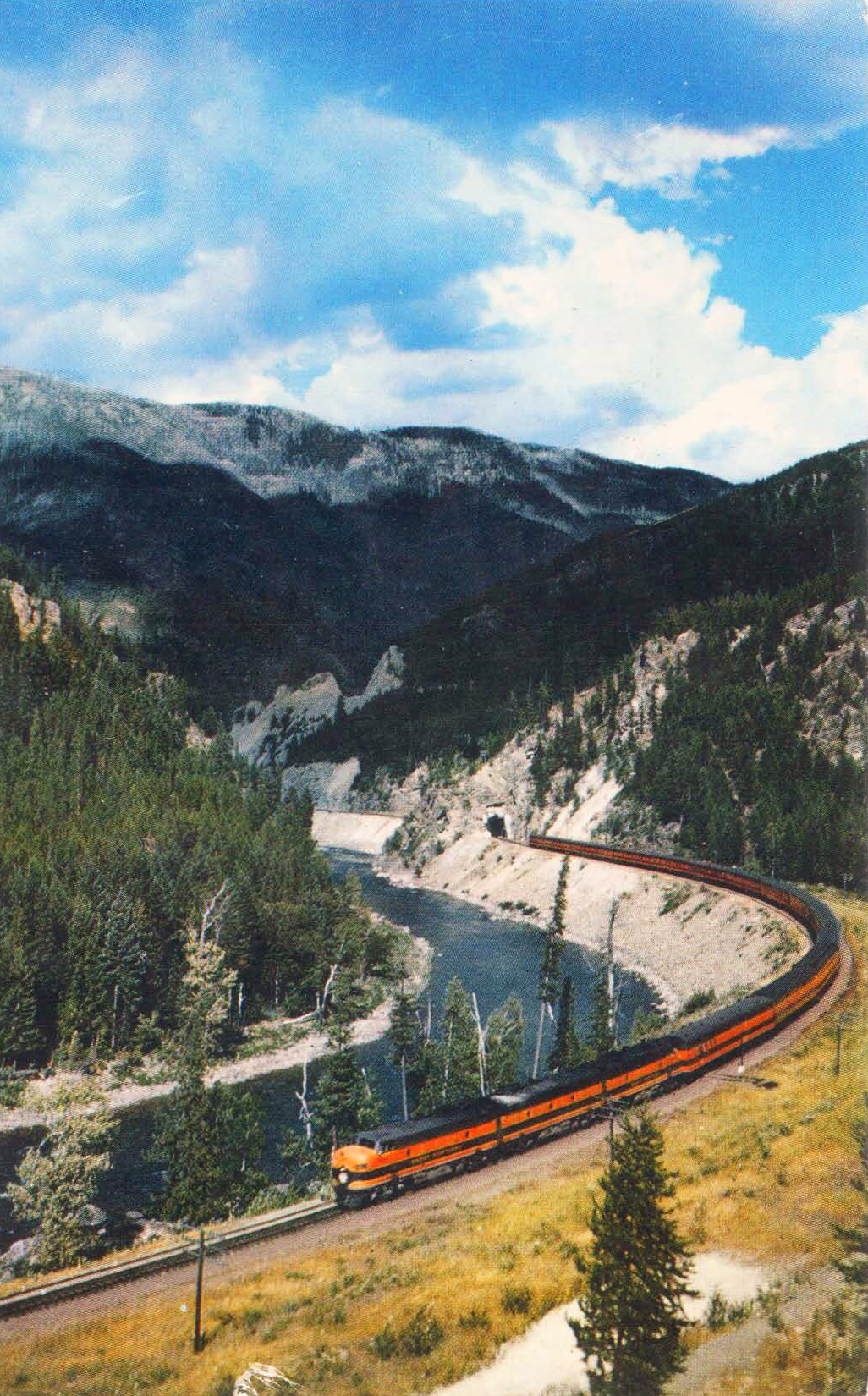 A Great Northern publicity photo featuring the "Western Star" along Montana's Flathead River, circa 1940's. Bob/Ira Spring photo.
A Great Northern publicity photo featuring the "Western Star" along Montana's Flathead River, circa 1940's. Bob/Ira Spring photo.The Star also gained the status as the primary train providing passengers access to the Glacier National Park, a task it continued to carry nearly through the end of its days.
As to be expected the Star's schedule was somewhat slower than its more prominent counterpart although not nearly as one might think. The train could make the run between Seattle and Chicago between 39 and 40 hours, only two hours slower than the Builder, and carried an average train speed of nearly 45 mph.
Consist (1952)
This schedule was more than seven hours faster than the NP's Mainstreeter. Given that the train was the GN's primary tourist service in the Northwest its busiest time of year was usually the summer months when the peak travel period between June and August saw the Star sometimes grow to five or more additional cars.
Throughout most of its service the Star was listed on GN's timetable as train's #3 (westbound) and #4 (eastbound). During the early 1960s a shuffling in passenger operations saw the train renumbered as #27 (westbound) and #28 (eastbound) as noted in the timetable featured above.
Timetable (1952)
One interesting note about the consist mentioned by Mike Schafer and Joe Welsh in their book, Streamliners: History of a Railroad Icon, is that it offered arguably more scenic views of the Rocky Mountains during its daytime run through the territory than the Builder despite the fact that the latter was the only domed transcontinental train offered by the Great Northern.
For power the Star utilized a wide range of power from Electro-Motive Division's FTs, F3s, F7s, and F9s to SDP40s, F45s, and SDP45s during the GN's final years of independent operation.
Timetable (January, 1970)
| Read Down Time/Leave (Train #47/Burlington) | Location | Read Up Time/Arrive (Train #24/Burlington) |
|---|---|---|
| (Monday) 10:45 PM (Dp) | (Thursday) 7:00 AM (Ar) | |
| (Tuesday) 7:15 AM (Ar) | (Wednesday) 10:45 PM (Dp) | |
| Time/Leave (Train #27/Great Northern) | Location | Time/Arrive (Train #28/Great Northern) |
| (Tuesday) 8:30 AM (Dp) | (Wednesday) 6:30 PM (Ar) | |
| 8:55 AM (Ar) | 6:00 PM (Dp) | |
| 9:05 AM (Dp) | 5:50 PM (Ar) | |
| 10:50 AM (Dp) | 4:05 PM (Ar) | |
| 12:40 PM (Dp) | 2:15 PM (Ar) | |
| 1:50 PM (Dp) | 1:10 PM (Dp) | |
| 3:20 PM (Dp) | 11:25 AM (Dp) | |
| 5:20 PM (Dp) | 9:30 AM (Dp) | |
| 7:35 PM (Ar) | 7:10 AM (Dp) | |
| 7:50 PM (Dp) | 6:55 AM (Ar) | |
| 10:05 PM (Ar) | 4:25 AM (Dp) | |
| (Tuesday) 9:20 PM (Dp) | 3:15 AM (Ar) | |
| (Wednesday) 12:05 AM (Dp) | (Wednesday) 12:05 AM (Dp) | |
| (Wednesday) 2:40 AM (Ar) | (Tuesday) 9:00 PM (Dp) | |
| (Wednesday) 6:10 AM (Ar) | (Tuesday) 5:15 PM (Dp) | |
| (Wednesday) 3:00 AM (Dp) | (Tuesday) 8:40 PM (Ar) | |
| 4:50 AM (Dp) | 6:55 PM (Dp) | |
| 5:25 AM (Dp) | 6:20 PM (Dp) | |
| F 6:34 AM (Dp) | F 5:10 PM (Dp) | |
| F 8:16 AM (Dp) | F 3:15 PM (Dp) | |
| 8:42 AM (Dp) | 2:45 PM (Dp) | |
| (Wednesday) 9:00 AM (Ar) | (Tuesday) 2:30 PM (Dp) | |
| (Wednesday) 9:10 AM (Dp) | (Tuesday) 2:20 PM (Ar) | |
| 11:35 AM (Dp) | 11:35 AM (Dp) | |
| 12:01 PM (Ar) | 11:10 AM (Dp) | |
| 11:05 PM (Dp) | 10:05 AM (Ar) | |
| 12:33 PM (Dp) | 8:40 AM (Dp) | |
| (Wednesday) 2:15 PM (Ar) | (Tuesday) 7:00 AM (Dp) | |
| (Wednesday) 3:00 PM (Dp) | (Tuesday) 6:15 AM (Ar) | |
| 6:30 PM (Ar) | 2:20 AM (Dp) | |
| 6:40 PM (Dp) | (Tuesday) 2:05 AM (Ar) | |
| 9:44 PM (Ar) | (Monday) 11:10 PM (Dp) | |
| 9:55 PM (Dp) | 10:50 PM (Ar) | |
| 10:20 PM (Dp) | 10:31 PM (Dp) | |
| (Wednesday) 11:00 PM (Ar) | (Monday) 10:00 PM (Dp) |
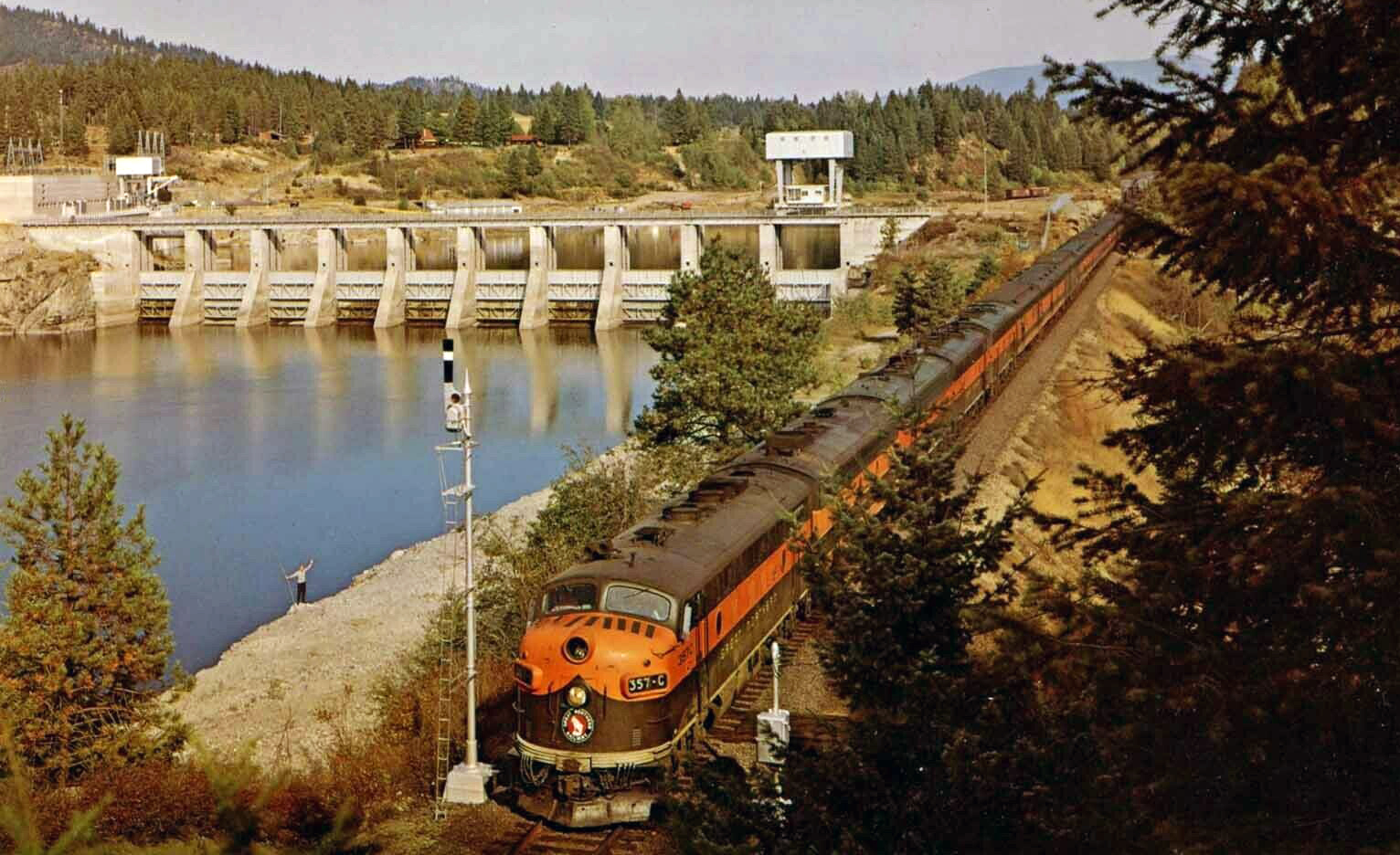 This Great Northern publicity photo features F3A #357-C leading train #27, the westbound "Western Star," as it passes the Albeni Falls Dam along the Pend Oreille River just east of Newport, Washington during the 1960's.
This Great Northern publicity photo features F3A #357-C leading train #27, the westbound "Western Star," as it passes the Albeni Falls Dam along the Pend Oreille River just east of Newport, Washington during the 1960's.Final Years
As rail patronage declined across the country through the 1950s and into the 1960s the Western Star saw its service cut back and as early as 1954 GN combined it with the Fast Mail between Spokane and Seattle.
Just prior to the Burlington Northern merger the train's typical consist included a few sleepers, a diner providing "budget meals and beverage service" (according to the timetable), and Day-Nite coaches. Its schedule had also slipped nearly 10 hours, completing a Chicago-Seattle run in just over 48 hours.
Through the end, however, the Star
remained part of the Burlington Northern's very brief passenger services with its final
run coming on April 30, 1971, as the next day Amtrak took over intercity
passenger rail operations.
Sources
- Hidy, Ralph W., Hidy, Muriel E., Scott, Roy V., And Hofsommer, Don L. Great Northern Railway, The: A History. Minneapolis: University of Minnesota Press, 2004 edition.
- Kelly, John. Great Northern Railway: Route Of The Empire Builder. Hudson: Iconografix, 2013.
- Schafer, Mike and Welsh, Joe. Streamliners, History of a Railroad Icon. St. Paul: MBI Publishing, 2003.
Contents
Recent Articles
-
Kansas - Murder Mystery - Dinner Train Rides
Dec 14, 25 11:02 AM
Kansas, known for its sprawling wheat fields and rich history, hides a unique gem that promises both intrigue and culinary delight—murder mystery dinner trains. -
New Jersey's 'Wine Tasting' Train Rides
Dec 13, 25 11:26 PM
If you're seeking a unique outing or a memorable way to celebrate a special occasion, wine tasting train rides in New Jersey offer an experience unlike any other. -
New Hampshire's 'Wine Tasting' Train Rides
Dec 13, 25 11:18 PM
This article details New Hampshire's most enchanting wine tasting trains, where every sip is paired with breathtaking views and a touch of adventure.

